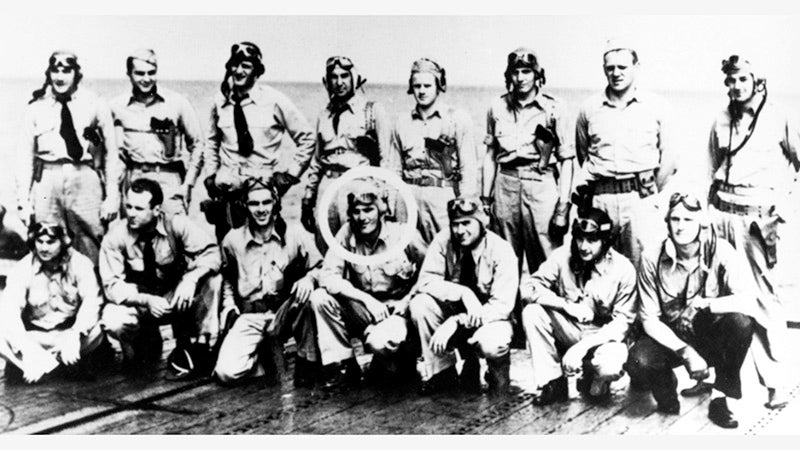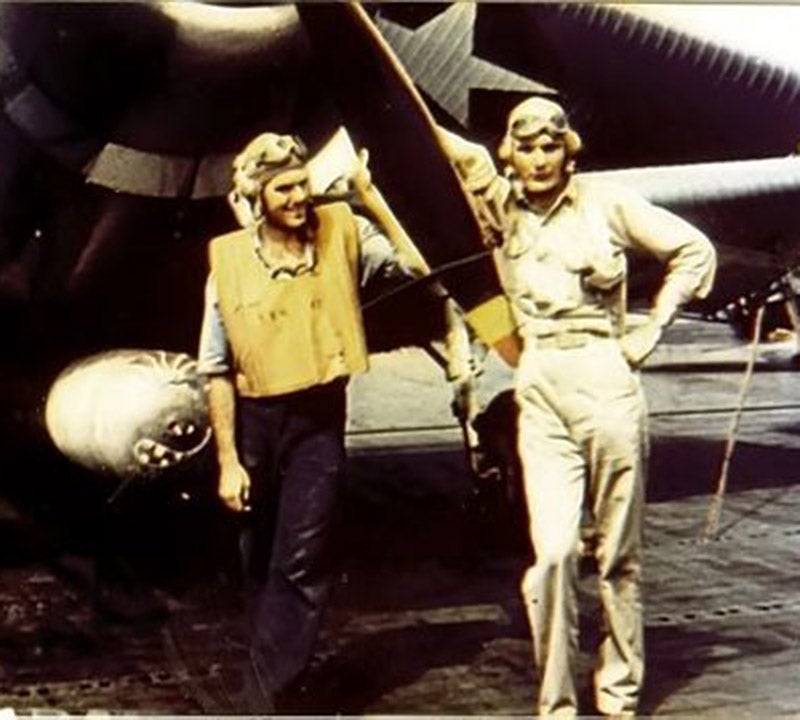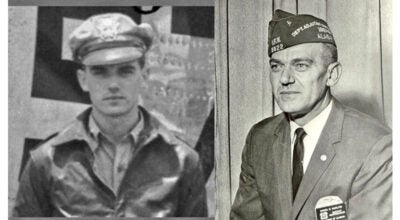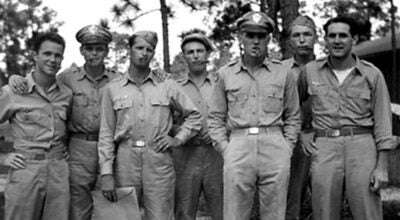A Father’s Day Dedication: The story of Torpedo Squadron 8 at the Battle of Midway
Published 5:03 pm Friday, June 18, 2021

- Photo of Torpedo Squadron 8 Pilots, taken in May 1942 before the Battle of Midway. The only survivor after the attack was Ens. George Gay [circled]. All 15 torpedo planes were lost and 29 of the 30 crewman. [Photo: Naval History and Heritage Command]
|
Getting your Trinity Audio player ready...
|
As we celebrate Father’s Day this year, we remember the sacrifices of all the young fathers who never returned from war. We should also remember those young men who died for their country, never having had the chance to become fathers. This story of Navy Torpedo Squadron 8 at the Battle of Midway is a reminder of the great sacrifices made by the young men of our armed forces, many of whom were teenagers who had left home for the first time and would never return.
Almost 80 years ago on June 4, 1942, 30 brave young men undertook a task so incredibly courageous that their actions on that day will be forever memorialized in the annals of U.S. Naval history. During the early hours of the Battle of Midway, Torpedo Squadron 8 [VT-8], flying from the aircraft carrier USS Hornet [CV-8] without fighter protection, carried out an attack against the vastly superior naval forces of Japan. That attack cost the lives of 29 of the 30 men in the squadron. This is their story.

Photo of Ens. George Gay [right] and his radioman, ARM3c Robert K. Huntington, taken sometime before the Battle of Midway. Huntington, was one of the 29 men killed during the initial torpedo attack. Gay was the sole survivor of VT-8. [Photo: en.wikipedia.org]
Torpedo Squadron 8 was created in 1941 as a part of the air group for the new carrier, USS Hornet. The new commander of VT-8 was Lcdr. John C. Waldron, a seasoned naval aviator from Ft. Pierre, S.D. Waldron had graduated from the Naval Academy in 1924 and had completed flight training in 1927. The new executive officer of VT-8 was Lt. Harold Larsen.
When the squadron started training, Waldron told Larsen, “We’re getting fresh, green kids. We’ve got to make fighting men out of them and we may not have much time”.
Waldron set about training the new squadron in the classroom as well as in the air. Their plane was the TBD Devastator, once considered a frontline torpedo plane but was obsolete by the time the Pacific war started. There were two big drawbacks to the TBD – it had light armament and required a low, slow approach speed while making a torpedo attack. The squadron was slated to receive the new Grumman TBF Avenger at about the time of Hornet’s departure from Norfolk, Va. Twenty-one new TBFs arrived in March 1942, just as Hornet was preparing to leave for the Pacific theater. Larsen was asked to stay behind in Norfolk with some of the squadron to begin training in the new Avengers. Hornet departed with Waldron, who took with him those pilots he deemed most experienced.
Hornet’s first taste of combat came when she was given the mission of transporting Lt. Col. James Doolittle’s squadron of Army Air Corps B-25s for the raid against Japan in April 1942. Waldron’s torpedo planes saw no action during that voyage. Because of the timing of the Doolittle Raid, Hornet did not participate in the Battle of the Coral Sea, which was the first naval battle in history in which the combatant ships never sighted each other visually. Such naval battles involving aircraft carriers would take place for the next three years
In May 1942, U.S. Naval intelligence at Honolulu learned that the Imperial Japanese Navy was planning an attack on the U.S. military base on Midway Island. On May 28, Hornet along with the USS Enterprise [CV-6] weighed anchor from Pearl Harbor and headed for an imaginary point designated as Point Luck where it hoped it would locate the Japanese fleet. The ship’s departure came just before VT-8 was to receive the new TBF Avengers that had already left the states. Lcdr. Waldron’s worst fear was confirmed when they departed with the old TBD Devastators. Complicating matters, Hornet’s new Air Group Commander, Cdr. Stanhope Ring, was newly appointed from an administrative position. His inexperience was a cause for concern among many of the air group’s pilots.
Plans for the upcoming battle called for a well-coordinated attack utilizing the fighters, dive-bombers and torpedo planes. Cdr. Ring wanted the aircraft to attack all-together but his plan differed from the successful tactics used in the Battle of the Coral Sea. He instructed his dive bomber pilots to fly high with fighter plane escorts in hopes of enticing the Japanese Zeroes to come up and fight. He instructed the torpedo planes to attack from almost wave-level without fighter escort. Lcdr. Waldron argued against Ring’s plan, stating that his torpedo planes needed fighter escorts and would be vulnerable because of their slow-speed torpedo attacks. Cdr. Ring insisted upon his disposition of the aircraft with the fighters high above and the torpedo planes without escorts.
On the morning of June 4, the Japanese carriers were sighted some 200 miles northwest of Midway. They had already launched their planes to attack Midway Island. Hornet’s pilots prepared to launch an attack, hoping to catch the Japanese carriers when they were most vulnerable with many of their planes headed toward Midway. In the ready room, Lcdr. Waldron briefed his men:
“My greatest hope is that we encounter a favorable tactical situation, but
if we don’t, and the worst comes to the worst, I want each of you to do his
utmost to destroy our enemies. If there is only one plane left to make a final
run-in, I want that man to go in and get a hit. May God be with us all. Good luck,
happy landings and give ‘em hell.” Finally, Waldron said, “This is it. It will be a
and I hope, a glorious event”
Shortly before planes were launched for the attack, all squadron commanders were called to the bridge for a briefing from the Task Force Commander, Admiral Marc Mitscher. Waldron made one last plea to have fighter escort for his torpedo planes. The fighter squadron commander, Lcdr. Pat Mitchell agreed with Waldron, but to no avail. Cdr. Ring’s plan would be followed. Finally, at 7:02 am, the first planes launched. Some 30 minutes later, all aircraft were airborne – there were 35 dive bombers, 15 torpedo planes and 10 fighters. At the same time Hornet was launching planes, strike groups from the nearby Yorktown and Enterprise were also launching.
As Ring took his dive bombers and fighters westward, climbing upward for their attack from high altitude, Waldron and his torpedo bombers headed in a slightly different direction at low altitude. Before long, the Devastators were alone and would not be a part of a coordinated attack. Only a couple of Waldron’s pilots had any combat experience. The squadron flew in two divisions, with one division having four sections of two planes, the other having two sections of two planes and one section of three – a total of 15 planes in all. In the last section of three planes, Ensign George Gay was flying last, the position known as tail-end Charlie.
While Ring’s planes were headed toward the projected position of the Japanese carriers, the Japanese commander, Admiral Nagumo decided to turn to the northeast after one of his search planes reported contact with Yorktown. That turn placed Nagumo’s carriers squarely in the path of Waldron and Torpedo Squadron 8.
The carriers were sighted by Waldron’s squadron at about 9:25 am. Waldron immediately radioed the position of the Japanese ships and asked for assistance in a coordinated attack. None of the other squadrons answered his call since they had turned south and were not in radio range. Realizing that the only option left was to attack, Waldron signaled his planes to form an attack formation, 60 feet above water.
They headed for the carrier located in the middle of the formation, some 16,000 yards distant. Suddenly the torpedo planes were swarmed by more than 30 Japanese Zeroes. One Devastator went down and was quickly followed by several more. Lcdr. Waldron’s last transmission was picked up by a radioman several miles away, “Watch those fighters!….My two wingmen are going into the water…”
Shortly after that, Waldron’s plane was hit and dropped toward the ocean with its left fuel tank ruptured and on fire. He was last seen, attempting to stand up and bail out as his plane plunged downward. His plane crashed into the water, burned briefly, and disappeared. In addition to the withering gun-fire from the Zeroes, anti-aircraft fire from the screening ships was wreaking havoc on the remaining planes of VT-8. In just a matter of minutes, Ensign George Gay was the only plane left to finish the attack. Just as he started his approach, Gay heard his rear gunner say that he had been hit. Glancing back, Gay realized his back-seat gunner was dead. Still, he pressed on with his attack through heavy antiaircraft fire and attacks by as many as five Zeroes. He dropped his torpedo at a range of 800 yards and flew through the hail of bullets directly over the carrier. He thought he heard an explosion but later reports revealed that no carrier had been hit during the attack. Gay’s Devastator was then attacked by another five or six Zeroes. He was wounded by shell fragments and hit in the left arm by a bullet. Even though his controls had been shot-up, Gay made a controlled, crash-landing about a quarter mile from the carrier. Gay made a frantic escape from the cockpit just before his plane disappeared beneath the waves He found himself floating among several items from his plane including the uninflated life raft and a small black cushion. Gay decided to inflate his life vest but not the life raft because he had heard stories about Japanese pilots machine-gunning downed pilots in life rafts. Trying to remain hidden under the black cushion, Gay assessed his injuries. He was able to remove the bullet from his arm and place it in his mouth for safe keeping. Before long the bullet was lost in the excitement of watching his fellow aviators wreak havoc among the Japanese carriers. With a ringside seat, Gay watched as U.S. dive bombers dropped their bombs on the pride of the Japanese fleet. Two carriers within Gay’s view took direct hits causing massive explosions and fires. At the end of the day, Japan had lost four of the six aircraft carriers that had attacked Pearl Harbor – the Akagi, Kaga, Soryu and Hiryu. The next day, a Navy PBY seaplane rescued Gay after he had spent 30 hours in the water. He eventually was taken to Pearl Harbor for recuperation. In the process, he had lost 24 lbs.
It has been documented that Torpedo Squadron 8 did no damage to the Japanese carriers they attacked. The futility of torpedo attacks by the older TBD aircraft was borne out by one more startling statistic -35 of the 40 planes flown against the Japanese at Midway were lost. However, an after-battle assessment concluded that their attack proved an invaluable distraction, causing the Japanese fighters to leave their high-altitude combat air patrols to defend their carriers against torpedo attack. The subsequent successful attacks by the dive bombers was met with little opposition before they commenced their attacks. An important note about those dive bomber pilots came out in a 1974 interview with George Gay. He reminded everyone that most of them were also flying their first combat missions that day.
The heroic role of Torpedo Squadron 8 during the Battle of Midway cannot be overstated. Ironically, each of the crew of VT-8 had been photographed in color before they left Honolulu. Famed Hollywood director, John Ford, filmed VT-8 in Honolulu sometime before the Battle of Midway. Ford, who was a member of the Navy Reserve, was also on Midway to film the expected battle. He had boarded Hornet the morning of June 3 to film the air crews before they launched. Later that year, the Navy released The Battle of Midway, a color documentary directed by John Ford. Ford was so moved after having met and talked with each member of VT-8 just hours before their deaths, that he made a short film “Torpedo Squadron 8,” just for the families of those brave airmen. That film can be found today on the internet by searching for “John Ford and Midway”. Duty, courage and sacrifice – the legacy of Torpedo Squadron 8 will forever be a proud part of the U.S. Navy’s history.
— John Vick
[Sources: Defense Media Network; Warfare History Network; Wikipedia; The Unwritten Record; Naval History and Heritage Command]





